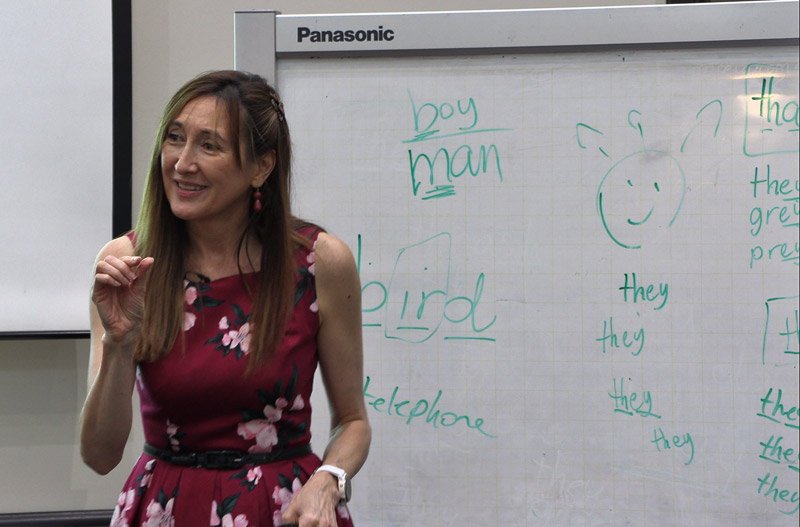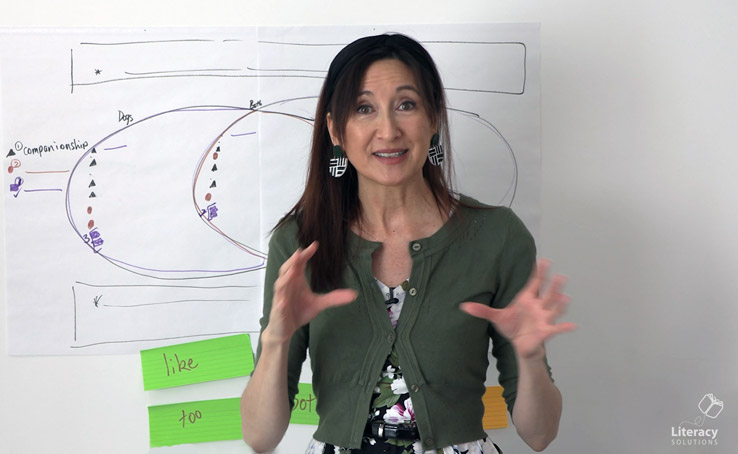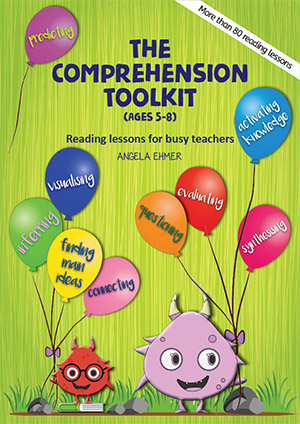References
(The Reading Wars: Time for a Truce?)
To read more:
Alfassi, M. (2004). Reading to Learn: Effects of Combined Strategy Instruction on High School Students. The Journal of Educational Research, 97(4), 171–184.
Allington, R.L. (2002). You can’t learn much from books you can’t read. Educational Leadership 60(3), 16-19.
Allington, R.L. (2009). What really matters in fluency. Research-based practices across the curriculum. Boston, MA: Pearson Education
Allington, R.L. (2013). What really matters when working with struggling readers. The Reading Teacher.
Becker, M., McElvany, N., and Kortenbruck, M. (2010). Intrinsic and extrinsic reading motivation as predictors of reading literacy: a longitudinal study. J. Educ. Psychol. 102, 773–785
Berninger, V.W., Richards, T.L. (2002). Brain Literacy for Educators and Psychologists. Elsevier Science, Academic Press, San Diego, CA
Booth, J. R., Perfetti, C. A., MacWhinney, B. (1999). Quick, automatic, and general activation of orthographic and phonological representations in young readers. Developmental Psychology, 35, 3-19.
Booth, J. R., Perfetti, C. A., MacWhinney, B., Hunt, S. B. (2000). The association of rapid temporal perception with orthographic and phonological processing in reading impaired children and adults. Scientific Studies of Reading, 4, 101-132.
Cain, T. & Hattie, J. (2019). Attitudes to school and reading achievement among secondary school students. Australian Journal of Education. 64(1), 5-24.
Cambourne, B. (2021). A Brief History of ‘The Reading Wars’. Edu Research Matters. https://www.aare.edu.au/blog/?p=9488
Carson, K.L, Gillon, G.T., & Boustead, T.M. (2013). Classroom phonological awareness instruction and literacy outcomes in the first year of school. Language, Speech, and Hearing Services in Schools, 44,147-160.
Cartwright, K.B. (2007). The contribution of graphophonological–semantic flexibility to reading comprehension in college students: Implications for a less simple view of reading, Journal of Literacy Research, 39, 2: 173–193.
Castles, A., Rastie, K. & Nation, K. (2018). Ending the Reading Wars: Reading Acquisition From Novice to Expert. Psychological Science in the Public Interest. Association for Psychological Science, 19, 5-51.
Clay, M. (1993). Reading Recovery: A Guidebook for Teachers in Training. Heinemann Education. Aukland.
Dreyer, L.G. & Katz, L. An Examination of “The Simple View of Reading”. Haskins Laboratories Status Report on Speech Research, 111, 112, 161-166.
Ehri, L.C. (2020). The Science of Learning to Read Words: A Case for Systematic Phonics Instruction. Reading Research Quarterly, 55, S45-S60.
Engen, L., & HØien, T. (2002). Phonological skills and reading comprehension. Reading and Writing: An Interdisciplinary Journal, 15, 613-631.
Faust, M. (2012). The The Handbook of the Neuropsychology of Language. Wiley Blackwell. West Sussex. UK.
George, K. & Das, J.M. (2021). Neuroanatomy, Thalamocortical Radiations. Updated 2021, July 31. In Stat Pearls.
Goodwin, A.P. & Jimenez, R.T. (2020). The Science of Reading: Supports, Critiques, and Questions. Reading Research Quarterly, 55, S7-S16.
Hoover, W. A., Gough, P. B. (1990). The simple view of reading. Reading and Writing, 2, 127–160.
Kamhi, A.G. (2009). The Case for the Narrow View of Reading. Language Speech and Hearing Services in Schools, 40 (2), 174-177.
Kaplan, D. & Walpole, S. (2005). A Stage-Sequential Model of Reading Transitions: Evidence From the Early Childhood Longitudinal Study. Journal of Educational Psychology, 97(4), 551-563.
Kilpatrick, D.A. (2015). Essentials of Assessing, Preventing, and Overcoming Reading Difficulties. Wiley.
King Rice, J. (2003). Teacher Quality: Understanding the Effectiveness of Teacher Attributes. Economic Policy Institute.
LeDoux, A. (2007). Investigating the Implementation of Whole Language: Strengths and Weaknesses. School of Education, Dominican University of California.
Martinez, R., ARICAK, Osman, Tolga, Jewell, J. (2008). Influence of reading attitude on reading achievement: A test of the temporal-interaction model. Psychology in the Schools. 45, 1010-1023.
Moats, L. (2005). How Spelling Supports Reading: And Why It Is More Regular and Predictable Than You May Think. American Educator. Winter 2005/2006, 12-43
Opper, I.M. (2019). Teachers matter: Understanding teachers’ impact on student achievement. RAND Corporation. https://www.rand.org/pubs/research_reports/RR4312.html
Opper, I. M. (2019). How Teacher Effectiveness Spills over into Other Classrooms. ERIC. RAND.
Petscher, Y., Cabell, S.Q., Catts, H.W., Compton, D.L., Foorman, B.R., Hart, S.A., Lonigan, C.J., Phillips, B.M., Schatschneider, C., Steacy, L.M., Patton Terry, N., Wagner, R.K. (2020). How the Science of Reading Informs 21st-Century Education. Reading Research Quarterly, 55, S267-S282.
Pressley, M. & Allington, R. (2=1999). What should reading instructional research be the research of? Issues in Education, 5(1), 1-35.
Pressley, M. , Duke, N & Boling, E. (2004). The Educational Science and Scientifically Based Instruction We Need: Lessons from Reading Research and Policymaking. Harvard Educational Review. 74(1), 30-61. Handbook of Reading Research.
Pressley, M., Duke, N.K., Gaskins, I.W., Fingeret, L., Halladay, J., Hilden, K., Park, Y., Zhang, S., Mohan, L., Reffitt, K., Bogaert, L.R., Reynolds, J., Golos, D., Solic, K., & Collins, S. (2009). Working with struggling readers: Why we must get beyond the Simple View of Reading and visions of how it might be done, in T.B. Gutkin & C.R. Reynolds (eds), The Handbook of School Psychology, Fourth Edition (522–546). Hoboken, NJ: Wiley.
Proctor, P. (2006) ‘The simple view as a psycholinguistic nucleus’. Paper presented at the National Reading Conference, 56th Annual Meeting, Los Angeles, CA, December.
Proctor, C.P., Carlo, M.S., August, D., & Snow, C.E. (2005) ‘Native Spanish-Speaking children reading in English: Toward a model of comprehension’, Journal of Educational Psychology, 97, 2: 246–56.
Proctor, C.P., August, D., Carlo, M.S., & Snow, C.E. (2006) ‘The intriguing role of Spanish vocabulary knowledge in predicting English reading comprehension’, Journal of Educational Psychology, 98, 1: 159–69.
Rayner, K., Carlson, M., & Frazier, L. (1983). The interaction of syntax and semantics during sentence processing: Eye movements in the analysis of semantically biased sentences. Journal of Verbal learning and Verbal behavior, 22, 358-374.
Rayner, K. & Duffy, S. A. (1986). Lexical complexity and fixation times in reading: Effects of word frequency, verb complexity, and lexical ambiguity. Memory & Cognition, 14, 191-201.
Rayner, K. & Floorman, B. Perfetti, C.A. Pesetsky, D. & Seidenberg, M. (2001). How psychological science informs the teaching of reading. Psychological Science in the Public Interest, (2), 31-74
Rayner, K., Foorman, B. R., Perfetti, C. A., Pesetsky, D., & Seidenberg, M. S. (2002). How should reading be taught? Scientific American, 286(3), 84-91
Reutzel, D.R., Cooter, R.B. (1990). Whole language: Comparative effects on first-grade reading achievement. Journal of Educational Research. 83(5).
Rose, J. (2006). Independent review of the teaching of early reading. Department of Education and Skills. Great Britain. https://dera.ioe.ac.uk/5551/2/report.pdf
Temereanca, S. & Simons, D.J. (2004). Functional Topography of Corticothalamic Feedback Enhances Thalamic Spatial Response Tuning in the Somatosensory Whisker/Barrel System, Neuron, 41(4), 639-651.
Wolfe, P. & Nevills, P. (2004). Building the Reading Brain, PreK-3, Corwin Press, California
Wong, H.K., & Wong, R.T. (2018). Classroom Management. The first days of school: how to be an effective teacher (5nd Edn).
Share, D.L. (2021). Is the Science of Reading Just the Science of Reading English? Reading Research Quarterly. 56, 391-402
Shaywitz, S. & Shaywitz, B. Overcoming Dyslexia. (2020 Edn.) Penguin Random House. New York
Torgeson, C.J., Brooks, G., & Hall, J. (2006) A Systematic Review of the Research Literature on the Use of Phonics in the Teaching of Reading and Spelling, London: Department for Education and Skills.
Wanzek, J., & Vaughn, S. (2007). Research based implications from extensive early reading interventions. School Psychology Review, 36, 41-561.
Wanzek, J., & Vaughn, S. (2008). Response to varying amounts of time in reading intervention for students demonstrating insufficient response to intervention. Journal of Learning Difficulties, 41, 126-142.
Wesley, A.H. & Tunmer, W.E. (2018). The Simple View of Reading: Three Assessments of Its Adequacy. Remedial and Special Education, 39, 304-312.
Willingham, D. (2009). Three problems in the marriage of neuroscience and education Discussion. Science Direct. 4S, 44-45.
Wolfe, P. & Nevills, P. (2004). Building the Reading Brain, PreK-3, Corwin Press, California
Wong, H.K., & Wong, R.T. (2018). Classroom Management. The first days of school: how to be an effective teacher (5nd Edn).




